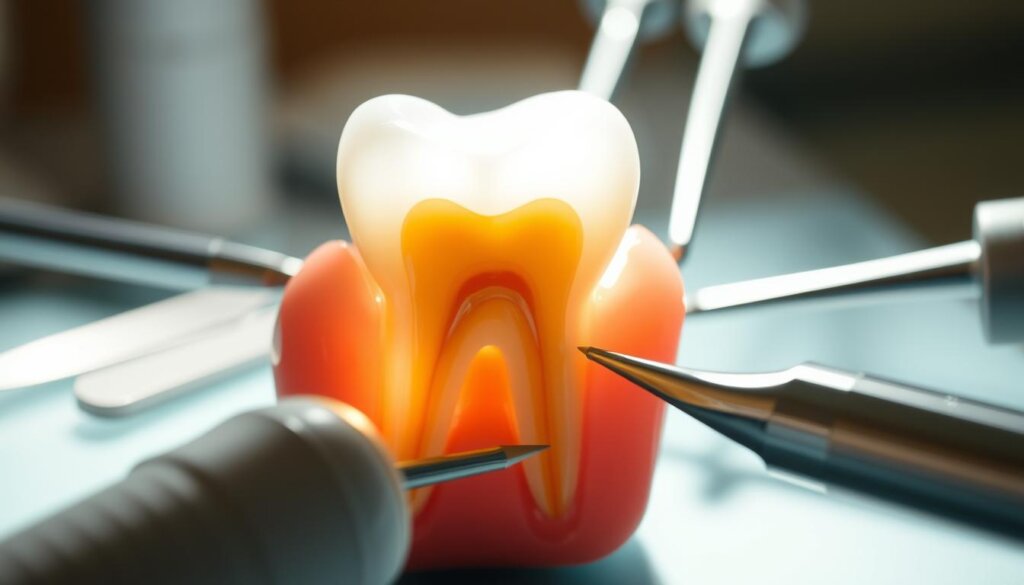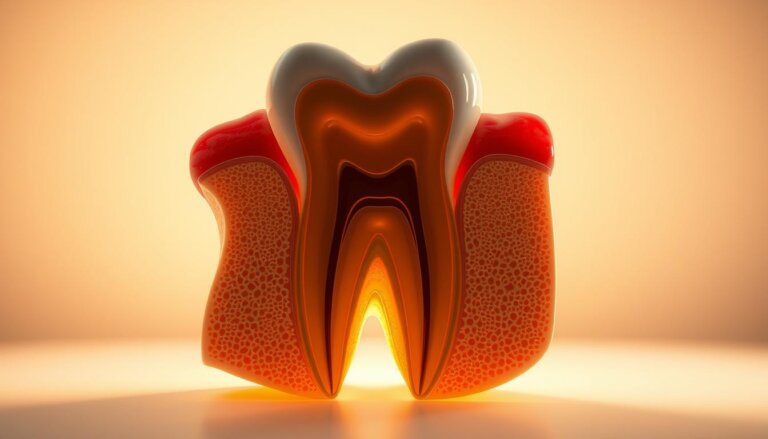What is a Root Canal Treatment, Exactly? What Does It Involve?
Every year, over 15 million people get root canal treatments. This shows how many are looking for relief from tooth pain without losing their teeth.
So, what is a root canal treatment? It’s a process where the infected pulp is removed. Then, the inside of the tooth is cleaned and sealed to prevent more harm. The Elms Dental Centre, Cleveland Clinic, and Mayo Clinic all say it helps keep your teeth and smile intact.
Key Takeaways
- A root canal clears out infected or inflamed pulp from inside a tooth.
- It preserves the tooth’s structure and helps maintain normal chewing.
- Modern methods focus on patient comfort and long-term success.
- Root canal therapy can stop pain from decay or trauma.
- Many dental experts recommend this option instead of extraction.
Understanding the Basics of Root Canal Treatment
When a tooth is damaged, a careful approach is needed. This method aims to relieve pain and stop infections. It protects the tooth by focusing on its inner structures.
Definition of Root Canal Treatment
Root canal therapy removes infected or inflamed pulp from the tooth’s inner chamber. It also disinfects and seals the canal to keep bacteria out. This helps prevent long-term pain and protects nearby tissues.
Importance of Root Canal Procedures
Healthcare experts stress the importance of this treatment. Cleveland Clinic says it can save natural teeth and reduce pain. The Elms Dental Centre adds that it prevents dental abscesses from coming back.
A successful root canal keeps your natural bite and reduces the need for more surgeries.
Reasons for Needing a Root Canal
Teeth face a lot of stress every day. Issues like plaque buildup, cracks, or bacteria can harm the pulp. That’s why root canal therapy is key for keeping teeth healthy.
Tooth Decay and Infection
Decay starts in the enamel and can spread deeper. If the pulp gets damaged, it can cause pain or swelling. Dentists say it’s important to treat it quickly to save the tooth.
Trauma to the Tooth
A hard hit or crack can hurt the pulp. This lets bacteria in. Signs like tooth sensitivity or color changes mean you might need a root canal. Acting fast can stop the infection.
Deep Cavities
Big cavities can harm the pulp. Poor dental care or big fillings can make things worse. Removing infected tissue stops further damage and keeps the area safe.
Keeping the tooth intact helps it work right. Getting help early can avoid bigger problems and keep your mouth healthy for a long time.
| Common Factors | Consequences |
|---|---|
| Bacterial infiltration | Inflamed pulp and severe discomfort |
| Physical injury | Fractured enamel allowing bacterial entry |
| Large fillings | Weak tooth structure and possible infection |
What to Expect During Your Consultation
Patients meet with a dentist or endodontist to talk about treatment for a sick tooth. They look at your dental history and check for infection. They also answer questions about treatments, like root canal surgery.
Initial Examination
The first step is a visual check of the tooth and gums. Mayo Clinic says X-rays or advanced imaging help find infection spots. This helps plan the treatment and check for deeper problems.
Diagnostic Tests
Doctors might tap the tooth or use hot and cold to check nerve responses. Some use a few methods:
- Gentle percussion on the tooth surface
- Temperature sensitivity checks
- Evaluation of gum pocket depths
These tests help decide the best course, like if root canal surgery is needed.
Treatment Planning
The team looks at images and decides on the treatment plan. They also consider sedation options for comfort. Elms Dental Centre talks about a cleaning and disinfecting process for success. Good planning makes patients feel secure and helps in achieving the best results.
The Root Canal Procedure Explained
This process targets the infected pulp at the tooth’s core. The American Association of Endodontists says it removes harmful bacteria. A root canal dentist then seals the space with safe materials, protecting the tooth.
Understanding the steps can make you feel more at ease. Many worry about pain. But, thanks to modern techniques, the procedure is now much more comfortable.
Anesthesia and Comfort Measures
Local anesthetics block pain signals. Sedation is available for those who are anxious. This ensures a calm experience during the treatment.
Steps of the Treatment
Several actions ensure a thorough result:
- Isolate the tooth with a sterile dam
- Remove damaged pulp
- Disinfect canals with medicated solutions
- Dry and fill the space to prevent reinfection
Cleaning and Shaping the Canal
Special instruments are used to reshape and widen each canal. This makes it easier to seal against bacteria. Working with a root canal dentist helps keep the tooth healthy for longer.
Aftercare Following a Root Canal
Proper aftercare is key for a healthy recovery and long-term oral function. Gums may feel tender after the procedure, but gentle care helps them heal. It’s important to watch for any changes in the restoration.
Immediate Post-Procedure Care
Stick to light chewing and soft foods to ease discomfort. Brush gently with a soft-bristled toothbrush to keep the area clean. Taking breaks helps avoid putting too much pressure on the tooth.
Pain Management Tips
According to Mayo Clinic, some soreness is normal. Over-the-counter pain relievers like ibuprofen can help. If pain persists, see your dentist. Keeping in touch with your dentist is important for your care.
Oral Hygiene Recommendations
Flossing daily helps prevent plaque. Regular dental cleanings are also essential. Taking care of your tooth helps it last longer. You might wonder about the cost of a root canal, which can include follow-up visits or crowns.
| Aftercare Step | Key Benefits |
|---|---|
| Gentle Brushing | Minimizes irritation and shields sensitive gum tissue |
| Soft Diet | Protects the treated site from strain or damage |
| Regular Checkups | Helps monitor tooth health and manage root canal cost |
Potential Risks and Complications
Every dental procedure, like endodontic work, has some risks. Studies from Mayo Clinic and Cleveland Clinic show most treatments work well. But, rare infections or lingering inflammation can happen if canals are not fully sealed. This is key for anyone wanting a healthy mouth for life.
Some people worry about pain, but modern endodontic methods aim to prevent it. If a hidden canal or failing filling causes pain, you might need more treatment. Getting checked early can stop bigger problems.
Common Side Effects
Mild gum or jaw tenderness usually goes away in a few days. Swelling might show up, but it usually goes down with the right medicine and rest.
When to Seek Further Treatment
Severe throbbing or long-lasting pain could mean a bigger issue. If symptoms don’t go away, seeing a dentist fast is a good idea. They can check for more serious damage.
| Risk | Possible Outcome |
|---|---|
| Re-infection | Recurrent swelling or ongoing pain |
| Retreatment | Another endodontic procedure or surgical approach |
Root Canal Treatment vs. Tooth Extraction
Dental experts often consider both options for damaged teeth. They usually choose to save the tooth because it helps with chewing and jaw alignment. The American Association of Endodontists also recommends keeping natural teeth to avoid more extensive dental work.
Benefits of Preserving the Tooth
Keeping your tooth helps with chewing and jaw alignment. It also keeps nearby teeth stable, reducing the chance of misalignment. The bone around the tooth stays strong, unlike after an extraction.
Preserving the tooth often means a smooth root canal recovery with less need for artificial replacements.
- Maintains natural bite stability
- Protects against future shifts
- Reduces additional procedures
Long-Term Outcomes Comparison
Extraction might prevent future infections but could lead to implants or bridges later. Saving the tooth usually means better root canal recovery without the need for lifelong prosthetics. Many people find it more comfortable and reduces the need for frequent dental visits.
The Role of Endodontists
Endodontists are dental experts who focus on saving teeth that seem lost. They have special training to handle deep canals and hidden infections. These issues can harm tooth health.
What Endodontists Specialize In
They are skilled in complex procedures like root canals and microsurgery. When usual methods fail, they use advanced tools. They also use magnification technology to find hidden canal paths.
Choosing an Endodontist
It’s important to check their credentials and ask for recommendations. Dentists often suggest endodontists for tricky cases. This ensures you get the best care.
Some might look into root canal alternatives. But endodontists usually aim to keep the natural tooth. This is in line with modern dental care, aiming for long-term health.
Myths About Root Canal Treatment
Many people worry about root canal therapy. Old ideas say it’s painful and takes many visits. But today’s methods are different. Dentists use new techniques to make it less painful and keep your teeth longer.
Common Misconceptions
- Root canal treatment is excruciating
- The procedure takes an excessive amount of time
- Extraction is the only quick solution
Facts to Consider
Modern tools find and fix the infection quickly. Most treatments are done in one or two visits. This helps keep your mouth healthy.
Thanks to root canal therapy, your teeth can stay strong. They can function and look normal again.
| Myth | Reality |
|---|---|
| Intense Pain | Modern anesthesia keeps discomfort minimal |
| Prolonged Procedure | Most treatments finish in one or two sessions |
| Better to Pull the Tooth | Saving natural teeth aids jaw stability and overall dental health |
Root Canal Treatment Success Rates
Results often stay good for many years. This method helps keep the tooth strong and functional. The quality of the restoration and patient care are very important for success.
Cleveland Clinic studies show that a well-done procedure and a strong restoration can make the tooth last forever.
Factors Affecting Success
Several things can affect how long the treatment lasts:
- Degree of infection or structural damage
- Oral hygiene habits at home
- Timely placement of a well-fitted crown
- Use of sterile techniques during therapy
Long-Term Prognosis
Today’s imaging and better sealing materials help protect the tooth. Many teeth stay healthy for years after treatment. Regular check-ups are key to keeping the tooth safe.
| Key Factor | Influence on Outcome | Recommendation |
|---|---|---|
| Infection Control | Reduces reinfection risk | Follow sterile protocols |
| Restorative Quality | Ensures proper sealing | Place well-designed crowns |
| Patient Care | Maintains tooth integrity | Practice thorough brushing |
Alternatives to Root Canal Treatment
Some people choose other options when a tooth is badly damaged. These alternatives aim to save as much tooth tissue as possible or replace the tooth. The right choice depends on balancing long-term results and personal comfort. Looking into () can help decide which option suits your lifestyle or budget.
Direct Restoration Options
These treatments keep as much of the tooth as possible if the pulp isn’t too damaged. They include:
- Composite Fillings: For small cavities where the tooth’s surface is mostly intact
- Onlays or Inlays: Custom pieces that protect healthy enamel
- Crowns: Caps that cover and strengthen the tooth
Each option aims to make the tooth stronger and functional with less invasive methods.
Dental Implants
The Elms Dental Centre suggests removing a severely damaged tooth and then placing a titanium post. This method needs enough bone and time for the implant to bond with the tissue. Many see implants as a solid choice, but treatment times can vary. Also, () can be checked to see if it’s right for you.
Costs and Insurance Coverage
Many people are curious about the root canal cost when looking into endodontic treatments for damaged teeth. Mayo Clinic data shows that costs can change based on the tooth’s location and the treatment’s complexity. Knowing the likely costs can help ease worries about expenses.

Average Cost of Treatment
Most costs come from diagnostic imaging, clinical procedures, and the restoration needed to protect the tooth. Front teeth usually have fewer canals, which can lower costs. Molars, on the other hand, may need more steps, increasing the price.
Several factors affect the cost, including:
- Extent of decay or infection
- Geographic location of the dental practice
- Specialized equipment or advanced techniques
Understanding Dental Insurance Plans
(Insurance coverage) is key in reducing treatment costs. Plans vary, but many cover part of the endodontic care costs. Co-pays and deductibles differ across policies.
Patients can get clear by reviewing each plan’s terms. They should also talk to providers to confirm specific coverage levels.
Future of Root Canal Treatments
New advancements in root canal therapy are exciting. They aim to save more natural teeth. Research and engineering are working together to make treatments faster and more effective.
Technological Advances
Cone-beam computed tomography (CBCT) from Carestream and Dentsply Sirona offers detailed 3D views. This helps dentists see each canal clearly. Ultrasonic tools clean more precisely, and bioactive materials help teeth heal.
Rotary file systems from Kerr and Dentsply make shaping teeth easier. They help remove infected tissue quickly and efficiently.
Innovations in Patient Comfort
Sedation and new anesthetics reduce anxiety and pain. This means shorter visits for patients. Comfortable settings and advanced imaging make patients feel more at ease.
Research in regenerative endodontics is also promising. It aims to keep teeth healthy for longer. These advancements are part of a bigger effort to improve dental care and overall health.






